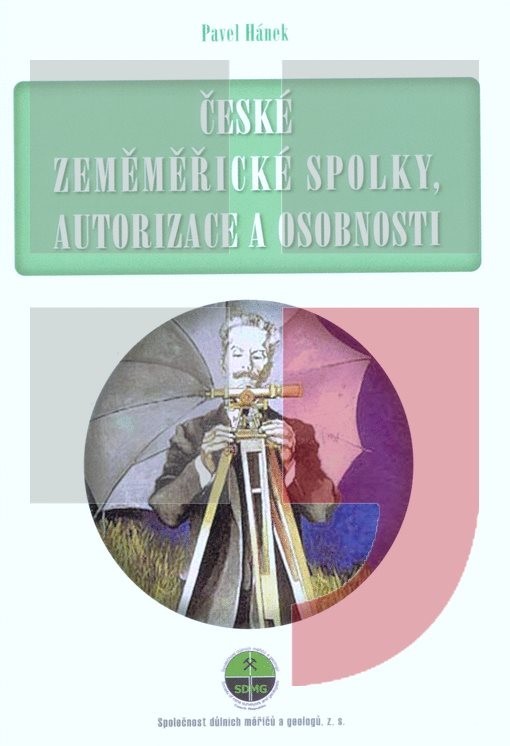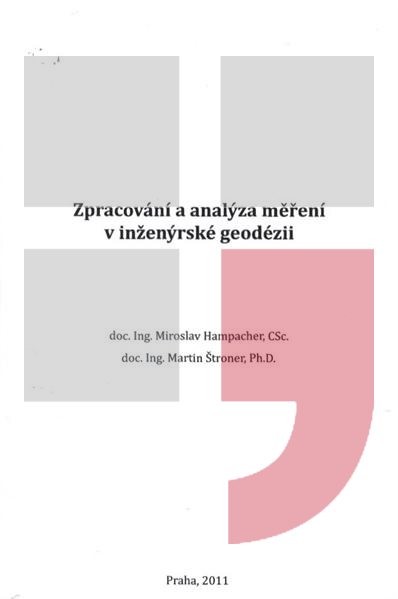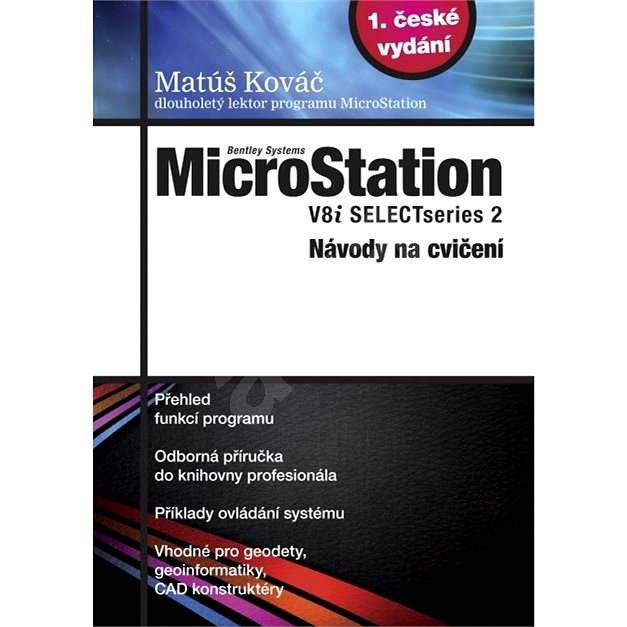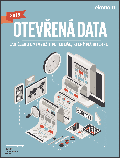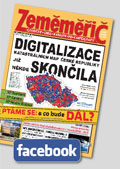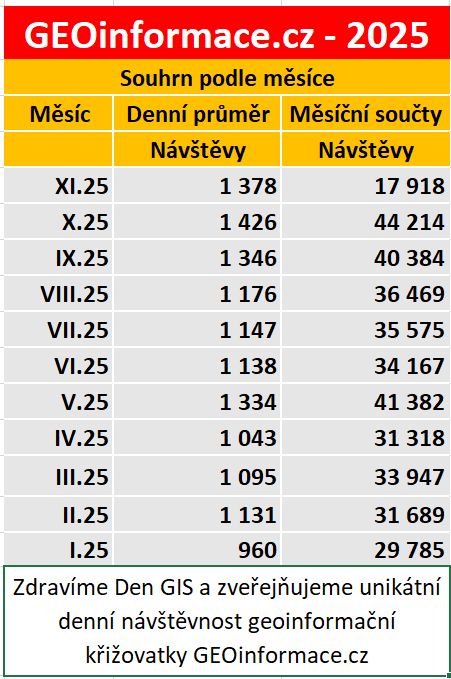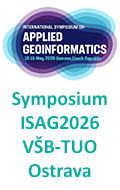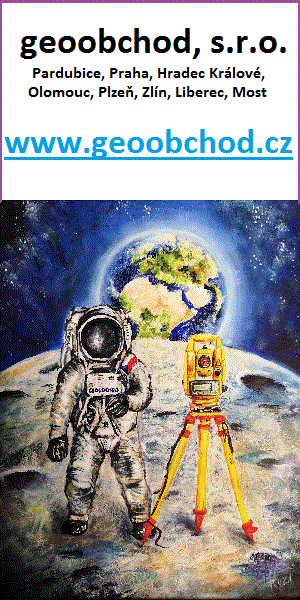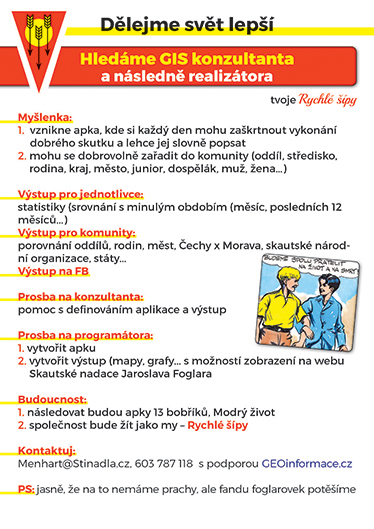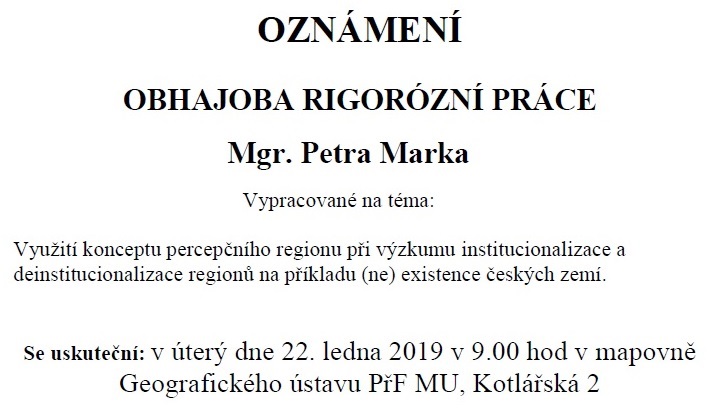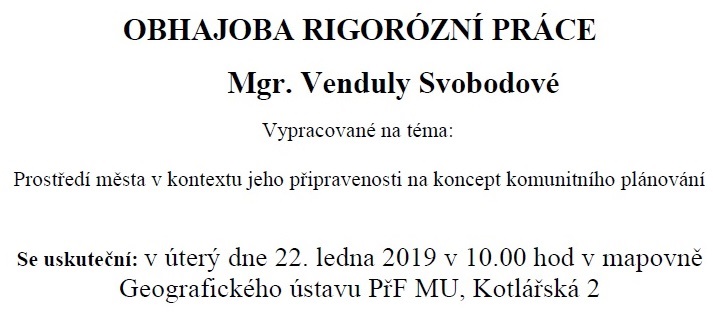zprávy
zdroje zpráv:02 vedoucí právního oddělení II.
24.1.2019 12:10 ČÚZK - předpisy a opatření Katastrální úřad pro hlavní město Prahu - Katastrální pracoviště Praha zveřejnil novou aktualitu: Ředitel úřadu vyhlašuje výběrové řízení na služební místovedoucí právního oddělení II.
odborný rada - právník
24.1.2019 12:10 ČÚZK - předpisy a opatření Katastrální úřad pro hlavní město Prahu - Katastrální pracoviště Praha zveřejnil novou aktualitu: Ředitel úřadu vyhlašuje výběrové řízení na služební místoOdborný rada - právník
odborný rada - právník
24.1.2019 12:08 ČÚZK /Urady/Katastralni-urady/Katastralni-urady/Katastralni-urad-pro-hlavni-mesto-Prahu/Uredni-deska/Oznameni-a-jina-uredni-sdeleni/Volna-mista/odborny-rada-pravnikodborný referent – poskytování informací a nahlížení do KN
24.1.2019 12:08 ČÚZK - volná místa Katastrální úřad pro hlavní město Prahu - Katastrální pracoviště Praha vypisuje výběrové řízení na místo odborný referent – poskytování informací a nahlížení do KNodborný rada - právník
24.1.2019 12:08 ČÚZK - předpisy a opatření Katastrální úřad pro hlavní město Prahu - Katastrální pracoviště Prahavypisuje výběrové řízení na místo
odborný rada - právník
odborný referent – poskytování informací a nahlížení do KN
24.1.2019 12:08 ČÚZK /Urady/Katastralni-urady/Katastralni-urady/Katastralni-urad-pro-hlavni-mesto-Prahu/Uredni-deska/Oznameni-a-jina-uredni-sdeleni/Volna-mista/odborny-rada-pravnikodborný rada - právník
24.1.2019 12:08 ČÚZK - volná místa Katastrální úřad pro hlavní město Prahu - Katastrální pracoviště Praha vypisuje výběrové řízení na místo odborný rada - právníkodborný referent – poskytování informací a nahlížení do KN
24.1.2019 12:08 ČÚZK - předpisy a opatření Katastrální úřad pro hlavní město Prahu - Katastrální pracoviště Prahavypisuje výběrové řízení na místo
odborný referent – poskytování informací a nahlížení do KN
Aktualizace katastrálních map
24.1.2019 12:05 Plzeňský kraj Ve všech mapových službách byla provedena aktualizace vektorových katastrálních map (DKM, KMD, KM-D a ÚKM). Data jsou s platností k 15. 12. 2018. Stav digitalizace je k dispozici zde. Pro práci s daty katastru nemovitostí je možné například využít tuto mapovou službu. Seznam všech mapových služeb je k dispozici zde.Verze 14.13 – několik úprav před většími změnami
24.1.2019 11:43 GEPROZveřejnili jsme verze 14.13 našich produktů MISYS, MISYS-WEB – licenční server, KOKEŠ, a PROLAND.… >>
Sustainable Ocean Alliance Announces $1.5M in funding, Releases First State of Our Ocean Annual Report
24.1.2019 11:13 GISCafe.com Webcasts-Webinars Funding will accelerate 100 ocean startups by 2021SOA Founder & CEO Daniela Fernandez available for one-on-one interviews in Davos
January 23, …
Aktualizace údajů
24.1.2019 10:49 Ústecký kraj V Geoportálu ÚAP Ústeckého kraje byla provedena aktualizace údajů pro poskytovatele Ústecký kraj - Krajský úřad Ústeckého kraje – jev 109Odborný referent/vrchní referent v oddělení aktualizace KN č. 2 na Katastrálním pracovišti Znojmo
24.1.2019 10:28 ČÚZK - volná místa Katastrální úřad pro Jihomoravský kraj - Katastrální pracoviště Znojmo vypisuje výběrové řízení na místo Odborný referent/vrchní referent v oddělení aktualizace KN č. 2 na Katastrálním pracovišti ZnojmoOdborný referent/vrchní referent v oddělení aktualizace KN č. 2 na Katastrálním pracovišti Znojmo
24.1.2019 10:28 ČÚZK - předpisy a opatření Katastrální úřad pro Jihomoravský kraj - Katastrální pracoviště Znojmovypisuje výběrové řízení na místo
Odborný referent/vrchní referent v oddělení aktualizace KN č. 2 na Katastrálním pracovišti Znojmo
Odborný referent/vrchní referent v oddělení aktualizace KN č. 2 na Katastrálním pracovišti Znojmo
24.1.2019 10:28 ČÚZK /Urady/Katastralni-urady/Katastralni-urady/Katastralni-urad-pro-Jihomoravsky-kraj/Uredni-deska/Oznameni-a-jina-uredni-sdeleni/Volna-mista/Odborny-referent-vrchni-referent-v-oddeleni-aktualPaving the way to new Galileo accuracy and authentication services: Galileo E6-B/C codes now available!
24.1.2019 10:26 European GNSS Agency
The main specifications of the Galileo E6-B and E6-C codes are now available to the User Community. These codes can be used for accessing the future Galileo High Accuracy Service (HAS) and Galileo Commercial Authentication Service (CAS) and can be downloaded from the Galileo Service Centre (GSC) website under the “Programme Reference Documents” section.
The main specifications of the Galileo E6-B/C codes have been published in a Technical Note - Galileo E6-B/C Codes Technical Note – which is now available to users via the Galileo Service Centre (GSC) website: https://www.gsc-europa.eu/
The description of the primary E6-B/C and secondary E6-C codes and their assignment to specific satellites will provide receiver manufacturers the information they need to develop Galileo E6-B/C enabled receivers. The Technical Note also provides a hexadecimal representation of the E6-B/C primary and secondary codes.
Value-added services
The Galileo User Community will be able to benefit from the added-value services, offered through the E6 signal, namely the Galileo High Accuracy Service and the Galileo Commercial Authentication Service:
• The Galileo High Accuracy Service (HAS) will allow users to obtain a positioning error below two decimetres in nominal conditions of use. The Galileo HAS will be based on the free transmission of Precise Point Positioning (PPP) corrections through the Galileo E6 signal data component (E6-B) by the Galileo satellites.
• The Galileo Commercial Authentication Service (CAS) will make it possible to authenticate signals, by giving access to the E6 signal pilot component (E6-C) codes, which will be encrypted.
Cost-effective solution
The Galileo high accuracy and authentication services will provide cost-effective solutions with very good performance and much needed redundancy that are essential for safety-critical applications, such as autonomous driving, for example.
To ensure that Galileo services continue to meet your needs, we encourage users to help us shape the future of Galileo! You can do this by completing the Galileo User Satisfaction Survey 2018, - it will only take you a few minutes!
For further up-to-date information on the Galileo system and its services, visit the European GNSS Service Centre (GSC) website or contact the Galileo Helpdesk.
Media note: This feature can be republished without charge provided the European GNSS Agency (GSA) is acknowledged as the source at the top or the bottom of the story. You must request permission before you use any of the photographs on the site. If you republish, we would be grateful if you could link back to the GSA website (http://www.gsa.europa.eu).
Paving the way to new Galileo accuracy and authentication services: Galileo E6-B/C codes now available!
24.1.2019 10:26 European GNSS Agency
The main specifications of the Galileo E6-B and E6-C codes are now available to the User Community. These codes can be used for accessing the future Galileo High Accuracy Service (HAS) and Galileo Commercial Authentication Service (CAS) and can be downloaded from the Galileo Service Centre (GSC) website under the “Programme Reference Documents” section.
The main specifications of the Galileo E6-B/C codes have been published in a Technical Note - Galileo E6-B/C Codes Technical Note – which is now available to users via the Galileo Service Centre (GSC) website: https://www.gsc-europa.eu/
The description of the primary E6-B/C and secondary E6-C codes and their assignment to specific satellites will provide receiver manufacturers the information they need to develop Galileo E6-B/C enabled receivers. The Technical Note also provides a hexadecimal representation of the E6-B/C primary and secondary codes.
Value-added services
The Galileo User Community will be able to benefit from the added-value services, offered through the E6 signal, namely the Galileo High Accuracy Service and the Galileo Commercial Authentication Service:
- The Galileo High Accuracy Service (HAS) will allow users to obtain a positioning error below two decimetres in nominal conditions of use. The Galileo HAS will be based on the free transmission of Precise Point Positioning (PPP) corrections through the Galileo E6 signal data component (E6-B) by the Galileo satellites.
- The Galileo Commercial Authentication Service (CAS) will make it possible to authenticate signals, by giving access to the E6 signal pilot component (E6-C) codes, which will be encrypted.
Cost-effective solution
The Galileo high accuracy and authentication services will provide cost-effective solutions with very good performance and much needed redundancy that are essential for safety-critical applications, such as autonomous driving, for example.
To ensure that Galileo services continue to meet your needs, we encourage users to help us shape the future of Galileo! You can do this by completing the Galileo User Satisfaction Survey 2018, - it will only take you a few minutes!
For further up-to-date information on the Galileo system and its services, visit the European GNSS Service Centre (GSC) website or contact the Galileo Helpdesk.
Media note: This feature can be republished without charge provided the European GNSS Agency (GSA) is acknowledged as the source at the top or the bottom of the story. You must request permission before you use any of the photographs on the site. If you republish, we would be grateful if you could link back to the GSA website (http://www.gsa.europa.eu).
rada/odborný rada – rozhodování o povolení vkladu
24.1.2019 10:21 ČÚZK - předpisy a opatření Katastrální úřad pro Olomoucký kraj - Katastrální pracoviště Prostějovvypisuje výběrové řízení na místo
rada/odborný rada – rozhodování o povolení vkladu
rada/odborný rada – rozhodování o povolení vkladu
24.1.2019 10:21 ČÚZK /Urady/Katastralni-urady/Katastralni-urady/Katastralni-urad-pro-Olomoucky-kraj/Uredni-deska/Oznameni-a-jina-uredni-sdeleni/Volna-mista/rada-odborny-rada-–-rozhodovani-o-povoleni-vkladurada/odborný rada – rozhodování o povolení vkladu
24.1.2019 10:21 ČÚZK - volná místa Katastrální úřad pro Olomoucký kraj - Katastrální pracoviště Prostějov vypisuje výběrové řízení na místo rada/odborný rada – rozhodování o povolení vkladuodborný rada – řízení o opravě chyby
24.1.2019 10:10 ČÚZK - volná místa Katastrální úřad pro Olomoucký kraj - Katastrální pracoviště Šumperk vypisuje výběrové řízení na místo odborný rada – řízení o opravě chybyodborný rada – řízení o opravě chyby
24.1.2019 10:10 ČÚZK - předpisy a opatření Katastrální úřad pro Olomoucký kraj - Katastrální pracoviště Šumperkvypisuje výběrové řízení na místo
odborný rada – řízení o opravě chyby
odborný referent v oddělení právní vztahy k nemovitostem
24.1.2019 8:39 ČÚZK /Urady/Katastralni-urady/Katastralni-urady/Katastralni-urad-pro-Vysocinu/Katastralni-pracoviste/KP-Jihlava/O-uradu/Aktuality/odborny-referent-v-oddeleni-pravni-vztahy-k-nemoviodborný referent v oddělení právní vztahy k nemovitostem
24.1.2019 8:39 ČÚZK - předpisy a opatření Katastrální úřad pro Vysočinu - Katastrální pracoviště Jihlava zveřejnil novou aktualitu: Oznámení o vyhlášení výběrového řízení na služební místo odborný referent v oddělení právní vztahy k nemovitostem Katastrálního pracoviště Jihlavaodborný referent v oddělení právní vztahy k nemovitostem Katastrálního pracoviště Jihlava
24.1.2019 8:33 ČÚZK - předpisy a opatření Katastrální úřad pro Vysočinu - Katastrální pracoviště Jihlavavypisuje výběrové řízení na místo
odborný referent v oddělení právní vztahy k nemovitostem Katastrálního pracoviště Jihlava
odborný referent v oddělení právní vztahy k nemovitostem Katastrálního pracoviště Jihlava
24.1.2019 8:33 ČÚZK /Urady/Katastralni-urady/Katastralni-urady/Katastralni-urad-pro-Vysocinu/Uredni-deska/Oznameni-a-jina-uredni-sdeleni/Volna-mista/odborny-referent-v-oddeleni-pravni-vztahy-k-nemoviodborný referent v oddělení právní vztahy k nemovitostem Katastrálního pracoviště Jihlava
24.1.2019 8:33 ČÚZK - volná místa Katastrální úřad pro Vysočinu - Katastrální pracoviště Jihlava vypisuje výběrové řízení na místo odborný referent v oddělení právní vztahy k nemovitostem Katastrálního pracoviště JihlavaGIS Ostrava 2019 (pozvánka)
24.1.2019 8:30 GISportal.cz
Katedra geoinformatiky VŠB-TU Ostrava pozýva na tradičnú konferenciu GIS Ostrava, ktorá sa uskutoční 20.3. – 22.3.2019 v Novej aule VŠB-TU. Ústrednou témou tohto ročníka konferencie sú tzv. chytré mestá („Smart City, Smart Region“). Ako kľúčoví rečníci sa predstavia Gerhard Navratil (TU Wien, Austria) a Blaž Zupan (Univ. Of Ljubljana, Slovenia). V rámci konferencie prebehnú aj zaujímavé semináre: […]
The post GIS Ostrava 2019 (pozvánka) appeared first on GISportal.cz.
GIS Ostrava 2019 (pozvánka)
24.1.2019 8:30 GISportal.cz
Katedra geoinformatiky VŠB-TU Ostrava pozýva na tradičnú konferenciu GIS Ostrava, ktorá sa uskutoční 20.3. – 22.3.2019 v Novej aule VŠB-TU. Ústrednou témou tohto ročníka konferencie sú tzv. chytré mestá („Smart City, Smart Region“). Ako kľúčoví rečníci sa predstavia Gerhard Navratil (TU Wien, Austria) a Blaž Zupan (Univ. Of Ljubljana, Slovenia). V rámci konferencie prebehnú aj zaujímavé semináre: […]
The post GIS Ostrava 2019 (pozvánka) appeared first on GISportal.cz.
Revolutionizing Crash Reconstruction with Drones and Lasers
24.1.2019 1:06 GISCafe.com Webcasts-Webinars Drones and lasers aide traffic crash officials in reducing secondary crashes by spending less time on scene.CENTENNIAL, Colo., Jan. 23, 2019 …
Autodesk Completes BuildingConnected Acquisition
23.1.2019 23:24 GISCafe.com Webcasts-Webinars Companies Aim to Create a Digital Marketplace for the Global Construction IndustrySAN RAFAEL, Calif., Jan. 23, 2019 — (PRNewswire) — …
Eleanor Crane, PhD named CTO of Enview
23.1.2019 19:56 GISCafe.com Webcasts-Webinars SAN FRANCISCO, Jan. 23, 2019 — (PRNewswire) — Enview, a Silicon Valley-based company using the latest in AI and machine learning to …CoreLogic Leverages Pushpin's Deep Learning Platform to Automatically Extract Property Attributes
23.1.2019 19:55 GISCafe.com Webcasts-Webinars Pushpin uses deep learning to increase accuracy and speed delivery.MINNEAPOLIS, Jan. 23, 2019 — (PRNewswire) —
MINNEAPOLIS, Jan. 23, …
Intel Announces New Class of RealSense Stand-Alone Inside-Out Tracking Camera
23.1.2019 19:55 GISCafe.com Webcasts-Webinars SANTA CLARA, Calif. — (BUSINESS WIRE) — January 23, 2019 —What’s New: Intel today introduced the Intel®
…
Accela Launches New Civic Application for Environmental Health to Help Agencies Protect Public Health in a Dynamic Regulatory Landscape
23.1.2019 19:55 GISCafe.com Webcasts-Webinars Out-of-the-box solution enables health departments to scale quickly and provide streamlined services to communities more efficientlySAN RAMON, …
EagleView Taps Former HP Executive to Spearhead Product Strategy as New Chief Product & Marketing Officer
23.1.2019 17:04 GISCafe.com Webcasts-Webinars Executive Michael Park joins EagleView leadership team as company looks to accelerate innovation and market penetrationBELLEVUE, Wash., Jan. 23, …
Velodyne Lidar and YellowScan Lead Drone Surveying Market for Highway Capacity Expansion
23.1.2019 17:04 GISCafe.com Webcasts-Webinars Unmanned Aerial Vehicle (UAV) surveying solution enables quick andeasy collection of detailed data on busy highway in Hungary
SAN …
Quantum Spatial to Highlight eGIS and LiDAR Projects at 2019 Esri Federal GIS Conference
23.1.2019 17:04 GISCafe.com Webcasts-Webinars ST. PETERSBURG, Fla., Jan. 23, 2019 (GLOBE NEWSWIRE) -- Quantum Spatial, Inc. (QSI), the nation’s largest independent geospatial analytics firm, …Taranis Launches Industry-First Automated Crop Emergence and Stand Count Solution
23.1.2019 17:04 GISCafe.com Webcasts-Webinars Leading AgTech Company Continues to Develop Offerings to Become the Most Comprehensive Crop-Monitoring Solution WorldwideTEL AVIV, Israel, Jan. 23, …
Aktualizace dat v mapových aplikacích
23.1.2019 15:00 Jihočeský kraj Mapová aplikace Technická infrastruktura a mapová aplikace Zastavěné území byly aktualizovány k 23.1.2019.User Consultation Platform helps shape the future of European GNSS
23.1.2019 12:33 European GNSS Agency
The European GNSS User Consultation Platform was hard at work in Marseille during this year's EU Space Week. Parallel panel sessions brought together users from different market segments. Each session had specific objectives aiming at profiting from the valuable contributions of users. The UCP ended with a plenary session in which the elected chairperson of each panel presented the results of their discussions to the wider community.
The User Consultation Platform (UCP) is a forum enabling direct interaction between users of positioning, navigation and time solutions and the organisations and institutions that oversee Galileo and EGNOS.
The UCP took place for the first time in 2017. The participants are actual users of the solutions, comprising representatives of associations such as standardisation bodies and industry groups, regulatory bodies and other members of the user community.
Watch this: EU Space Week in Marseille, 3 - 6 December 2018
The 2018 meeting of the UCP took place at the elegant Pharo Palace with spectacular views overlooking Marseille's old port. The platform was divided, on the first day, into subgroups representing the professional, transport and mass markets. A plenary to bring them together took place on the second day. Tasks undertaken by each group included discussing and validation of user needs and requirements on positioning, navigation and time technologies that can later be evaluated and, for those relevant to GNSS, implemented in the EGNOS and Galileo programmes. The ones that cannot be implemented in the current technology baselines will be taken into consideration for future evolutions of the systems. Feedback on current Galileo Service Centre user support was also elicited among other topics of the upmost importance such as R&D priorities, PNT backup solutions, high accuracy services, etc.
What the users said
The Platform's plenary session was open to all participants in European Space Week. Members of the plenary audience were encouraged to comment and to ask questions as the chairpersons of each of the eight individual sectors reported the results of their discussions. A panel of representatives of the European Commission and the European GNSS Agency listened attentively to the messages delivered by the presenters, asking their own questions whenever necessary.
Key insights from the working sessionsMass Market As an outcome of the mass-market users’ consultation session, the fastest growing mass market applications identified were robotics, people and asset tracking, safety and emergency, and m-health. In the area of robotics Philip Mattos, Positioning and Technology expert at GNSS module manufacturer U-Blox and chair of the mass-market platform, highlighted how spoofing-proof solutions are currently of particular interest, especially for robots that carry valuable loads. Road Transport Reporting for the road transport session was François Fischer, Senior Manager Connected and Automated Driving at ERTICO. He said that in the key application area of automated driving, no single existing technology can equal the navigation and location performance currently being delivered by GNSS. Complementary technologies, however, such as cameras, HD maps and motion sensors can help to reach minimum performance requirements. Aviation Russell Dudley, from the European Regions Airlines Association, reported on discussions on user requirements for different applications, including for aircraft distress tracking. Remote activation is a new functionality under analysis to be offered by Galileo via its return link, to prevent cases such as MH370 or other 'non-cooperative aircraft'. Airlines confirmed interest in the service and support activities to validate the end-to-end concept, including all actors such as air traffic control. Rail Transport According to chairperson Salvatore Sabina of Ansaldo STS, the rail sector recommends continuing work on defining the rail-related service to be provided by EGNOS, including all service provision aspects. The sector would also like to see what alternatives are possible for the transmission of EGNOS corrections enabling future use in rail safety relevant applications, based on the conclusions of the STARS project. Maritime and Inland Waterways Reporting for the maritime sector, Jean-Pierre Barboux of FDC pointed out the high dependency on GNSS in that area. He said back-ups for positioning, timing and synchronisation all need to be further analysed. There is also current interest in high-accuracy positioning, especially for port navigation. Agriculture Aerovision CEO Tamme Van Der Wal discussed research innovation priorities. He said there was a key interest in exploiting synergies with other initiatives, including existing public-private partnerships, the Partnership for Research and Innovation in the Mediterranean Area, and especially with Copernicus, the EU's flagship Earth Observation programme. Surveying and Mapping Roberto Capua, Responsible for GNSS R&D at Sogei, said the surveying and mapping industries are eagerly anticipating upcoming European GNSS services. Of special interest here are: the high-accuracy service; the authentication function, especially for drones and institutional applications; dual-frequency signals; and the Ionospheric Prediction Service. Timing and Synchronisation Ilaria Sesia, Responsible for Galileo Timing Activities at the Italian National Metrology Institute, said the most relevant European GNSS service for timing and synchronisation is Galileo Open Service Navigation Message Authentication. The sector has great expectations for this Galileo differentiator and would like to see this service deployed as quickly as possible. New and emerging applications of particular interest were analysed, such as Digital Video Broadcasting, autonomous cars, data management centres and scientific applications as well as upcoming 5G. |
Positive reception
Considering the depth and breadth of the presentations, as well as the response from gathered EU Space Week delegates, the 2018 UCP exercise was very productive. Fiammetta Diani, Head of Market Development at the GSA, said all the comments, suggestions and requests were important and would be properly assessed to determine how they can influence the evolution of European GNSS services.
GSA Executive Director Carlo des Dorides thanked all the UCP participants for their engagement and said: “The GSA works very hard to maintain close relationships with our GNSS users, and that means all stakeholders in the downstream markets. An important part of the value of the GSA is built on these relationships.”
Matthias Petschke, European Commission Director of EU Satellite Navigation Programmes, said: “What this User Consultation shows is that we are listening to you. Unlike other GNSS around the world, Galileo is a demand-driven programme. We want to hear your ideas and we want to know what you need, to bring your ideas to the market and create businesses.”
The event in Marseille was the second full UCP meeting. The first meeting took place in November 2017 in Madrid.
Media note: This feature can be republished without charge provided the European GNSS Agency (GSA) is acknowledged as the source at the top or the bottom of the story. You must request permission before you use any of the photographs on the site. If you republish, we would be grateful if you could link back to the GSA website (http://www.gsa.europa.eu).
Odborný rada – rozhodování o povolení vkladu v oddělení právních vztahů k nemovitostem
23.1.2019 12:10 ČÚZK - předpisy a opatření Katastrální úřad pro Zlínský kraj - Katastrální pracoviště Uherské Hradištěvypisuje výběrové řízení na místo
Odborný rada – rozhodování o povolení vkladu v oddělení právních vztahů k nemovitostem
Odborný rada – rozhodování o povolení vkladu v oddělení právních vztahů k nemovitostem
23.1.2019 12:10 ČÚZK - volná místa Katastrální úřad pro Zlínský kraj - Katastrální pracoviště Uherské Hradiště vypisuje výběrové řízení na místo Odborný rada – rozhodování o povolení vkladu v oddělení právních vztahů k nemovitostemOdborný rada – rozhodování o povolení vkladu v oddělení právních vztahů k nemovitostem
23.1.2019 12:10 ČÚZK /Urady/Katastralni-urady/Katastralni-urady/Katastralni-urad-pro-Zlinsky-kraj/Uredni-deska/Oznameni-a-jina-uredni-sdeleni/Volna-mista/Odborny-rada-–-rozhodovani-o-povoleni-vkladu-v-oddRozpočet úřadu za rok 2019
23.1.2019 12:08 ČÚZK - předpisy a opatření Český úřad zeměměřický a katastrálnívystavuje rozpočet úřadu za rok
2019
Rozpočet úřadu za rok 2019
23.1.2019 12:08 ČÚZK /Urady/Cesky-urad-zememericky-a-katastralni/Rozpocty/Rozpocet-uradu-za-rok-201920190123 - Úpravy v poskytování katastrální mapy ve VFK
23.1.2019 10:07 ČÚZK - Výměnný formát ISKN Od 28.2.2019 dojde k ukončení poskytování vektorové katastrální mapy ve VFK dělených po KP (http://services.cuzk.cz/vfk/kp/) a dat potvrzených geometrických plánů rovněž dělených po KP (http://services.cuzk.cz/vfk-gmpl/kp/). Současně s tím dojde od 23.1.2019 k přidání:- bloku definičních bodů do souborů s vektorovou katastrální mapou ve VFK distribuovanou po k.ú.,
- nové datové sady souborů s vektorovou katastrální mapou ve VFK distribuovanou po k.ú. v režimu změnových vět (http://services.cuzk.cz/vfk-zmeny/ku/).
20190123 - volné místo - Odborný/vrchní referent v OD KN na KP Teplice
23.1.2019 9:42 ČÚZK - předpisy a opatření Katastrální úřad pro Ústecký kraj - Katastrální pracoviště Teplice zveřejnil novou aktualitu: Nabídka volného pracovního místa - Odborný/vrchní referent v oddělení dokumentace katastru nemovitostí na Katastrálním pracovišti Teplice (po dobu RD)20190123 - volné místo - Odborný/vrchní referent v OD KN na KP Teplice
23.1.2019 9:42 ČÚZK /Urady/Katastralni-urady/Katastralni-urady/Katastralni-urad-pro-Ustecky-kraj/O-uradu/Aktuality/20190123-volne-misto-Odborny-vrchni-referent-v20190123 - volné místo - Odborný/vrchní referent v OD KN na KP Teplice
23.1.2019 9:42 ČÚZK - předpisy a opatření Katastrální úřad pro Ústecký kraj - Katastrální pracoviště Teplice zveřejnil novou aktualitu: Nabídka volného pracovního místa - Odborný/vrchní referent v oddělení dokumentace katastru nemovitostí na Katastrálním pracovišti Teplice (zástup za RD, cca do r.2021)Odborný/vrchní referent v oddělení dokumentace katastru nemovitostí na Katastrálním pracovišti Tepli
23.1.2019 9:39 ČÚZK /Urady/Katastralni-urady/Katastralni-urady/Katastralni-urad-pro-Ustecky-kraj/Uredni-deska/Oznameni-a-jina-uredni-sdeleni/Volna-mista/Odborny-vrchni-referent-v-oddeleni-dokumentace-katOdborný/vrchní referent v oddělení dokumentace katastru nemovitostí na Katastrálním pracovišti Tepli
23.1.2019 9:39 ČÚZK - předpisy a opatření Katastrální úřad pro Ústecký kraj - Katastrální pracoviště Teplicevypisuje výběrové řízení na místo
Odborný/vrchní referent v oddělení dokumentace katastru nemovitostí na Katastrálním pracovišti Teplice (po dobu RD)
Odborný/vrchní referent v oddělení dokumentace katastru nemovitostí na Katastrálním pracovišti Tepli
23.1.2019 9:39 ČÚZK - volná místa Katastrální úřad pro Ústecký kraj - Katastrální pracoviště Teplice vypisuje výběrové řízení na místo Odborný/vrchní referent v oddělení dokumentace katastru nemovitostí na Katastrálním pracovišti TepliCzechTourism představil novou výstavní expozici pro světové veletrhy tvořenou především našimi leteckými fotkami
23.1.2019 9:23 UpVision CzechTourism představil svoji novou výstavní expozici pro světové veletrhy, kterou opět tvoří především naše nové letecké fotografie.Náhled zde:
https://plus.google.com/u/0/b/115833877689730865211/+UpvisionCz1/posts/MQcCEkvHnjL
20190123 Rada/odborný rada – interní auditor Katastrálního úřadu pro Středočeský kraj
23.1.2019 8:25 ČÚZK /Urady/Katastralni-urady/Katastralni-urady/Katastralni-urad-pro-Stredocesky-kraj/O-uradu/Aktuality/20190121-Rada-odborny-rada-oddeleni-podpory-IC-(1)20190123 Rada/odborný rada – interní auditor Katastrálního úřadu pro Středočeský kraj
23.1.2019 8:25 ČÚZK - předpisy a opatření Katastrální úřad pro Středočeský kraj Vyhlášení výběrového řízení: Rada/odborný rada – interní auditor Katastrálního úřadu pro Středočeský kraj V části "Úřední deska", v sekci "Oznámení a jiná úřední sdělení" bylo vystaveno "Oznámení o vyhlášení výběrového řízení na obsazení služebního místa Rada/odborný rada – interní auditor Katastrálního úřadu pro Středočeský kraj"Rada/odborný rada – interní auditor Katastrálního úřadu pro Středočeský kraj
23.1.2019 8:24 ČÚZK /Urady/Katastralni-urady/Katastralni-urady/Katastralni-urad-pro-Stredocesky-kraj/Uredni-deska/Oznameni-a-jina-uredni-sdeleni/Volna-mista/Rada-odborny-rada-–-interni-auditor-KatastralnihoRada/odborný rada – interní auditor Katastrálního úřadu pro Středočeský kraj
23.1.2019 8:24 ČÚZK - volná místa Katastrální úřad pro Středočeský kraj vypisuje výběrové řízení na místo Rada/odborný rada – interní auditor Katastrálního úřadu pro Středočeský kraj20190123 Vrchní referent/rada oddělení aktualizace PI KN I.
23.1.2019 8:09 ČÚZK - předpisy a opatření Katastrální úřad pro Středočeský kraj - Katastrální pracoviště Praha-východ zveřejnil novou aktualitu: Vrchní referent/rada oddělení aktualizace PI KN I. V části "Úřední deska", v sekci "Oznámení a jiná úřední sdělení" bylo vystaveno "Oznámení o vyhlášení výběrového řízení na obsazení služebního místa Vrchní referent/rada oddělení aktualizace PI KN I."20190123 Vrchní referent/rada oddělení aktualizace PI KN I.
23.1.2019 8:09 ČÚZK /Urady/Katastralni-urady/Katastralni-urady/Katastralni-urad-pro-Stredocesky-kraj/Katastralni-pracoviste/KP-Praha-vychod/O-uradu/Aktuality/20180601-(2)OneWeb Satellites has shipped first satellites for the OneWeb constellation to launch site
23.1.2019 8:08 GISCafe.com Webcasts-Webinars Toulouse, France, 22 January 2019 - OneWeb Satellites, a joint venture between Airbus and OneWeb, today announced the delivery of the first …Vrchní referent/rada oddělení aktualizace PI KN I.
23.1.2019 8:07 ČÚZK - předpisy a opatření Katastrální úřad pro Středočeský kraj - Katastrální pracoviště Praha-východvypisuje výběrové řízení na místo Vrchní referent/rada oddělení aktualizace PI KN I.
Vrchní referent/rada oddělení aktualizace PI KN I.
Vrchní referent/rada oddělení aktualizace PI KN I.
23.1.2019 8:07 ČÚZK /Urady/Katastralni-urady/Katastralni-urady/Katastralni-urad-pro-Stredocesky-kraj/Uredni-deska/Oznameni-a-jina-uredni-sdeleni/Volna-mista/Vrchni-referent-rada-oddeleni-aktualizace-PI-KN-IVrchní referent/rada oddělení aktualizace PI KN I.
23.1.2019 8:07 ČÚZK - volná místa Katastrální úřad pro Středočeský kraj - Katastrální pracoviště Praha-východ vypisuje výběrové řízení na místo Vrchní referent/rada oddělení aktualizace PI KN I.Odborný referent / vrchní referent – poskytování informací KN, poskytování podkladů, nahlížení do KN
23.1.2019 7:20 ČÚZK - předpisy a opatření Katastrální úřad pro Zlínský kraj - Katastrální pracoviště Vsetínvypisuje výběrové řízení na místo
Odborný referent / vrchní referent – poskytování informací KN, poskytování podkladů, nahlížení do KN, poskytování informací PK v oddělení dokumentace KN
Odborný referent / vrchní referent – poskytování informací KN, poskytování podkladů, nahlížení do KN
23.1.2019 7:20 ČÚZK - volná místa Katastrální úřad pro Zlínský kraj - Katastrální pracoviště Vsetín vypisuje výběrové řízení na místo Odborný referent / vrchní referent – poskytování informací KN, poskytování podkladů, nahlížení do KNOdborný referent / vrchní referent – poskytování informací KN, poskytování podkladů, nahlížení do KN
23.1.2019 7:20 ČÚZK /Urady/Katastralni-urady/Katastralni-urady/Katastralni-urad-pro-Zlinsky-kraj/Uredni-deska/Oznameni-a-jina-uredni-sdeleni/Volna-mista/Odborny-referent-vrchni-referent-–-poskytovani-iVýroční zpráva dle zákona č. 106/1999 Sb. za rok 2018
23.1.2019 7:10 ČÚZK /Urady/Katastralni-urady/Katastralni-urady/Katastralni-urad-pro-Vysocinu/Vyrocni-zpravy/Vyrocni-zprava-dle-zakona-c-106-1999-Sb-za-rok-2Výroční zpráva dle zákona č. 106/1999 Sb. za rok 2018
23.1.2019 7:10 ČÚZK - předpisy a opatření Katastrální úřad pro Vysočinuvydává výroční zprávu úřadu za rok
2018
CORINE Land Cover 2018 (ATOM)
23.1.2019 1:00 Cenia - Katalog metadat ČR - INSPIRE Předpřipravená datová sada, která obsahuje soubory (CLC18_CZ, CLC12R_CZ a CHA18_CZ) ve formátu SHP archivované do formátu ZIP. Data jsou zpřístupněna prostřednictvím služby ATOM. CLC18_CZ - Databáze s klasifikací pokryvu zemského povrchu v rozsahu ČR v roce 2018. Databáze CLC 2018 byla interpretována z aktualizované databáze CLC 2012. Velikost nejmenší mapovací jednotky pro polygony CLC 2018 je 25 ha.CLC12R_CZ - Revidovaná databáze s klasifikací pokryvu zemského povrchu v rozsahu ČR v roce 2012. V rámci tvorby databáze CLC 2018 byla revidována a aktualizována databáze CLC 2012. Velikost nejmenší mapovací jednotky pro polygony CLC 2012 je 25 ha.CHA18_CZ - Změnová databáze byla odvozena z databáze s klasifikací pokryvu zemského povrchu v roce 2012 vizuálním porovnáním rastrových podkladů z roku 2012 a 2018. Zaznamenány byly všechny změny splňující mapovací kritéria (rozloha > 5 ha, posun hranic > 100 m).Smart city tématem sympozia GIS Ostrava 2019
22.1.2019 19:46 GeoBusiness Organizátoři sympozia GIS Ostrava 2019 uveřejnili témata letošní akce. Geoinformační infrastruktury, DTM Zdroje geodat Dálkový průzkum Země (vč. UAV) Smart city Smart region Smart ... PřečístStudenti, přihlaste svoji práci na konferenci GISáček
22.1.2019 19:34 GeoBusiness Až do 10. března 2019 mohou studenti přihlásit svoji práci do letošního ročníku studentské konference GISáček 2019. Konference GISáček je určená studentům vysokých škol, kteří ... PřečístTémata konference Mapy jsou pro každého 2019
22.1.2019 19:09 GeoBusiness Jak na základě prostorových informací, map a dat efektivně a zodpovědně rozhodovat? V jaké podobě potřebujeme informace pro bezpečná a udržitelná rozhodnutí? Jak inovovat, ... PřečístBAE Systems Expands National Geospatial-Intelligence Agency Mission Support and Establishes New Tech Council to "Map" Agency Innovation
22.1.2019 18:51 GISCafe.com Webcasts-Webinars MCLEAN, Va. — (BUSINESS WIRE) — January 22, 2019 —The National Geospatial-Intelligence Agency (NGA) has awarded BAE
…
Bittium and Esri Join PSTA as Platinum Members
22.1.2019 18:51 GISCafe.com Webcasts-Webinars The Public Safety Technology Alliance (PSTA) is pleased to announce the addition of Bittium, a provider of secure communications solutions, and Esri, …USAA Joins Geospatial Intelligence Center
22.1.2019 16:54 GISCafe.com Webcasts-Webinars Longtime NICB member sees value in approach to disaster responseDES PLAINES, Ill., Jan. 22, 2019 — (PRNewswire) — USAA, one of …
Drone Aviation Concludes Training of U.S. Army Unit on Next-Gen WASP ERS Tactical Aerostat
22.1.2019 16:54 GISCafe.com Webcasts-Webinars JACKSONVILLE, FL, Jan. 22, 2019 (GLOBE NEWSWIRE) -- Drone Aviation Holding Corp. (OTCQB: DRNE) (“Drone Aviation” or the “Company”), a …New Kespry Construction Innovations Further Drive Project Profitability by Enhancing Drone Flight and On-Demand Data Accuracy
22.1.2019 16:54 GISCafe.com Webcasts-Webinars Kespry introduces new capabilities to support construction companies to accurately track and drive project progress, and highlights customer …New financial resources for Copernicus space component
22.1.2019 16:50 ESA Observing the Earth
An amendment to the current Copernicus Agreement has been signed by the EU and ESA, adding €96 million to ESA’s space component budget for the world’s largest environmental monitoring programme: Copernicus.
Konference Mapy jsou pro každého 2019
22.1.2019 16:01 CENIA - národní geoportál INSPIRE Nadace Partnerství pořádá již pátý ročník odborné konference Mapy jsou pro každého, která proběhne v termínu 4 - 5. 6. 2019 v Hotelu Luna na Vysočině. Registrovat se můžete zde. Více informací naleznete na www.giskonference.cz.Konference Mapy jsou pro každého 2019
22.1.2019 16:01 CENIA - národní geoportál INSPIRE Nadace Partnerství pořádá již pátý ročník odborné konference Mapy jsou pro každého, která proběhne v termínu 4 - 5. 6. 2019 v Hotelu Luna na Vysočině. Využijte online registraci za zvýhodněných podmínek a přihlaste i své odborné příspěvky. Více na www.giskonference.cz.Rozpočet úřadu za rok 2019
22.1.2019 15:23 ČÚZK - předpisy a opatření Zeměměřický úřadvystavuje rozpočet úřadu za rok
2019
Rozpočet úřadu za rok 2019
22.1.2019 15:23 ČÚZK /Urady/Zememericky-urad/Rozpocty/Rozpocet-uradu-za-rok-2019Rozpočet úřadu za rok 2019
22.1.2019 15:23 Zeměměřický úřad Zeměměřický úřadvystavuje rozpočet úřadu za rok
2019
20190122 odborný referent/ vrchní referent v oddělení aktualizace PI KN I.
22.1.2019 15:14 ČÚZK - předpisy a opatření Katastrální úřad pro Středočeský kraj - Katastrální pracoviště Praha-východ zveřejnil novou aktualitu: odborný referent/ vrchní referent v oddělení aktualizace PI KN I. V části "Úřední deska", v sekci "Oznámení a jiná úřední sdělení" bylo vystaveno "Oznámení o vyhlášení výběrového řízení na obsazení systemizovaného místa odborný referent/ vrchní referent v oddělení aktualizace PI KN I."20190122 odborný referent/ vrchní referent v oddělení aktualizace PI KN I.
22.1.2019 15:14 ČÚZK /Urady/Katastralni-urady/Katastralni-urady/Katastralni-urad-pro-Stredocesky-kraj/Katastralni-pracoviste/KP-Praha-vychod/O-uradu/Aktuality/20180601-(1)odborný referent/ vrchní referent v oddělení aktualizace PI KN I.
22.1.2019 15:13 ČÚZK - volná místa Katastrální úřad pro Středočeský kraj - Katastrální pracoviště Praha-východ vypisuje výběrové řízení na místo odborný referent/ vrchní referent v oddělení aktualizace PI KN I.odborný referent/ vrchní referent v oddělení aktualizace PI KN I.
22.1.2019 15:13 ČÚZK /Urady/Katastralni-urady/Katastralni-urady/Katastralni-urad-pro-Stredocesky-kraj/Volna-mista/odborny-referent-vrchni-referent-v-oddeleni-aktuaodborný referent/ vrchní referent v oddělení aktualizace PI KN I.
22.1.2019 15:13 ČÚZK - předpisy a opatření Katastrální úřad pro Středočeský kraj - Katastrální pracoviště Praha-východvypisuje výběrové řízení na místo odborný referent/ vrchní referent v oddělení aktualizace PI KN I.
odborný referent/ vrchní referent v oddělení aktualizace PI KN I.
Zveřejnění obsahu informací poskytnutých na žádost dle zákona č. 106/1999 Sb. za rok 2019
22.1.2019 14:27 ČÚZK /Urady/Katastralni-urady/Katastralni-urady/Katastralni-urad-pro-Vysocinu/Casto-hledane-informace/Poskytovani-informaci-106-1999-Sb/Zverejneni-obsahu-informaci-poskytnutych-na-za-(1)/Zverejneni-obsahu-informaci-poskytnutych-na-za-(1)Zveřejnění obsahu informací poskytnutých na žádost dle zákona č. 106/1999 Sb. za rok 2019
22.1.2019 14:27 ČÚZK - předpisy a opatření Katastrální úřad pro Vysočinuzveřejňuje obsah informace poskytnutých na žádost dle zákona č. 106/1999 Sb. za rok
2019
Airbus fellows to join ESA’s ɸ-lab
22.1.2019 14:14 ESA Observing the Earth
ESA’s new Earth observation innovation hub, ɸ-lab, is set to welcome three research fellows from the aerospace industry giant Airbus, to work at the edge of disruptive technologies that monitor Earth’s environment from space.
Rozpočet úřadu za rok 2019
22.1.2019 13:56 ČÚZK - předpisy a opatření Katastrální úřad pro Vysočinuvystavuje rozpočet úřadu za rok
2019
Rozpočet úřadu za rok 2019
22.1.2019 13:56 ČÚZK /Urady/Katastralni-urady/Katastralni-urady/Katastralni-urad-pro-Vysocinu/Rozpocet/Rozpocet-uradu-za-rok-2019Rada / odborný rada – rozhodování o povolení vkladu v oddělení právních vztahů k nemovitostem
22.1.2019 13:29 ČÚZK - předpisy a opatření Katastrální úřad pro Zlínský kraj - Katastrální pracoviště Kroměřížvypisuje výběrové řízení na místo
Rada / odborný rada – rozhodování o povolení vkladu v oddělení právních vztahů k nemovitostem
Rada / odborný rada – rozhodování o povolení vkladu v oddělení právních vztahů k nemovitostem
22.1.2019 13:29 ČÚZK /Urady/Katastralni-urady/Katastralni-urady/Katastralni-urad-pro-Zlinsky-kraj/Uredni-deska/Oznameni-a-jina-uredni-sdeleni/Volna-mista/Rada-odborny-rada-–-rozhodovani-o-povoleni-vkladRada / odborný rada – rozhodování o povolení vkladu v oddělení právních vztahů k nemovitostem
22.1.2019 13:29 ČÚZK - volná místa Katastrální úřad pro Zlínský kraj - Katastrální pracoviště Kroměříž vypisuje výběrové řízení na místo Rada / odborný rada – rozhodování o povolení vkladu v oddělení právních vztahů k nemovitostemInformace o výsledcích kontrol dle § 26 zákona č. 255/2012 Sb. za rok 2018
22.1.2019 10:41 ČÚZK - předpisy a opatření Český úřad zeměměřický a katastrálnívydává informace o výsledcích kontrol dle § 26 zákona č. 255/2012 Sb. za rok
2018
Výroční zpráva dle zákona č. 106/1999 Sb. za rok 2018
22.1.2019 9:57 ČÚZK - předpisy a opatření Katastrální úřad pro Jihočeský krajvydává výroční zprávu úřadu za rok
2018
Výroční zpráva dle zákona č. 106/1999 Sb. za rok 2018
22.1.2019 9:57 ČÚZK /Urady/Katastralni-urady/Katastralni-urady/Katastralni-urad-pro-Jihocesky-kraj/Vyrocni-zpravy/Vyrocni-zprava-dle-zakona-c-106-1999-Sb-za-rok-2Rozpočet úřadu za rok 2019
22.1.2019 8:52 ČÚZK - předpisy a opatření Katastrální úřad pro hlavní město Prahuvystavuje rozpočet úřadu za rok
2019
Rozpočet úřadu za rok 2019
22.1.2019 8:52 ČÚZK /Urady/Katastralni-urady/Katastralni-urady/Katastralni-urad-pro-hlavni-mesto-Prahu/Rozpocet/Rozpocet-uradu-za-rok-2019Trimble Expres 2019 představí trendy v totálních stanicích
22.1.2019 8:01 Zeměměřič Na konferenci je vstup zdarma, představeny budou technologické novinky firmy Trimble.Nejrychlejší 3D laserový skener bude na Leica Tour 2019
22.1.2019 7:01 Zeměměřič Gefos představí novinky a cenové akce na své tradiční Leica Tour 2019.Prezentace z konference State of the map CZ+SK na webu
22.1.2019 7:00 Česká asociace pro geoinformacePrezentace z konference State of the map CZ+SK na webu
Čtvrtý ročník české a slovenské konference o OpenStreetMap, State of the map CZ+SK, se konal ve dnech 2. a 3. listopadu 2019 na FIT VUT v Brně. Na weových stránkách jsou nyní k dispozici prezentace a videa z přednášek.
Čtvrtý ročník české a slovenské konference o OpenStreetMap, State of the map CZ+SK, se konal ve
GIVS 2019 - Přihlašte se za zvýhodněné vložné
22.1.2019 7:00 Česká asociace pro geoinformaceDo 15. března je možné se přihlásit na letošní ročník konference Geoinformace ve veřejné správě za zvýhodněné vložné. V minulých letech však byla často tou dobou kapacita konferenčního sálu již naplněna. Neotálejte proto s registrací a přihlašte se na konferenci prostřednictvím webového formuláře už dnes.
Veškeré další informace naleznete na
Bezplatné používání ArcGISu
22.1.2019 6:51 GeoBusiness Firma Esri oznámila nové možnosti pro vývojáře. Začínajícím dokonce nabízí bezplatné používání ArcGISu. Bezplatný přístup Pokud vaše webová aplikace nebude vytvářet obrat, tak můžete ... Přečíst[Copernicus Academy & Copernicus Relays] summer school, tender and greetings from the CSO
22.1.2019 6:50 Dear members of the Copernicus Academy and representatives of the Copernicus Relays, We would like to share with you two news items: 1. The Summer School “Copernicus for Digital Earth” will take place from 23 June to 4 July 2019 in Salzburg, Austria. It will explore the potential of freely available satellite data with a focus on […]6 years PostDoc Position – TU Vienna – Spatial HCI Lab
22.1.2019 6:49 The Geoinformation Group at TU Vienna in Austria is looking for a Post-Doctoral researcher, starting the earliest possible. We would like you to contribute to our research in the areas of Human-Computer Interaction and Geographic Information Science. The position is not tied to a specific predetermined project. Some of the areas we are interested in are: spatial human-computer interaction, human […]Fully funded PhD position – VGI – Leicester
22.1.2019 6:48 Dear all, the University of Leicester is offering a fully funded PhD position to work with me, Dr Nick Tate and Dr Andrea Ballatore (Birkbeck, University of London) on charting the diverse geographies of User-Generated Content. Please see further information below and let me know if you have any questions or queries. Please feel free to forward […]Pozvánka na obhajoby rigorózních prací: P. Marek, V. Svobodová, J. Bieľák
22.1.2019 0:00 Geografický ústav MUOznámení o omezení provozu Pobočky Hradec Králové
22.1.2019 0:00 Státní pozemkový úřad Z důvodu přerušení dodávky vody je v úterý 22. 1. 2019 od 11:30 h omezen provoz na PK Hradec Králové (KPÚ pro Královéhradecký kraj).Software pro misi ExoMars prošel zkušebními jízdami
21.1.2019 23:06 Český Kosmický PortálNavigační software určený pro misi ExoMars 2020 prošel zkušebními jízdami, k nimž došlo na „martovské zahrádce“ ESA.
Future City Competition Caries On Last Weekend, Thanks To A Little Help From InterDev
21.1.2019 17:41 GISCafe.com Webcasts-Webinars InterDev helps to secure not only a state-of-the-art competition location but also additional sponsors for the Future City Competition …Média: téma kartografického dne v Olomouci
21.1.2019 15:30 GeoBusiness Všichni zájemci o kartografii jsou zváni na třináctý kartografický den v Olomouci, který se bude konat v pátek 22. února 2019 v budově Přírodovědecké ... PřečístIntroducing the MyGalileoApp Competition
21.1.2019 14:16 European GNSS Agency
The European GNSS Agency’s (GSA) new MyGalileoApp competition challenges developers to design, develop, test and launch a mobile application that takes advantage of the increased accuracy and availability provided by Galileo. The winner stands to win up to EUR 100,000.
Do you have an innovative idea for an application that could benefit from the precise positioning offered by Galileo? Whether it be in the area of augmented reality, geo-marketing, smart navigation, social networking or otherwise – the GSA wants to help you take your idea from concept to reality.
The GSA’s MyGalileoApp Competition challenges developers to design, develop, test and commercially launch a mobile application that provides a position and/or time fix using a Galileo-enabled smartphone equipped with Android /IOS operating system. It must also demonstrate how the increased accuracy/availability provided by Galileo within a multi-constellation/multi-frequency solution adds value to the application.
Each proposed application should target one of the following areas:
- Smart navigation and infotainment
- Augmented reality and games
- Geo marketing and advertising
- Fitness, sport and mHealth
- Enterprise applications
- Social networking
- Mapping, GIS and agriculture
- Automated mobility (all transport modes)
- Aviation
- Drones
- Finance
“The MyGalileoApp Prize will help application developers embrace Galileo’s full potential to create new tools and services,” says Carlo des Dorides, GSA Executive Director. “Through this competition, the GSA is encouraging market adoption of Galileo by supporting the development of mobile applications that address end user needs.”
And did we mention that the winner will receive EUR 100,000?
Interested?
Now that we have your attention, it’s time to get started. To compete, all you have to do is submit a proposal describing how your application addresses one of the 11 development areas, and how it will use Galileo to do so. The deadline for submissions is 28 March 2019. Proposals can be submitted here.
All proposals will be reviewed by GSA experts, who will select a maximum of 30 projects to proceed to the development phase. During this phase, contestants are required to develop a beta version of their app and be able to demonstrate at least 50% functionality. To help, the GSA will provide a dedicated API and online mentoring.
After careful evaluation, the judges will select a maximum of 10 projects to continue to the next phase of the contest. Here, projects must deliver a finalised version of the application with 100% functionality. Those that succeed will be invited to the Finals, where they will present their application to the GSA evaluation board.
Following the presentations, the judges will announce the winners, with the first-place winner receiving a EUR 100,000 prize. The runner up and third place finishers will receive EUR 50,000 and EUR 30,000 respectively.
Let’s talk details…
The MyGalileoApp competition is open to all mobile application developers, entrepreneurs, students, researchers and anybody else who’s up for the challenge (so long as you are at least 18 years of age). You can compete as an individual or a team. All teams are required to appoint a team coordinator, who must be an EU citizen, while other team members can also be from outside the EU. Team members may also represent legal entities as long as this entity has its central administration or registered office in the EU.
At all stages of the contest, projects will be evaluated using the following criteria:
- Innovation: is this kind of solution not yet available on the market? Is the application technologically advanced (e.g. using multi-frequency, innovating algorithms)?
- Market potential: is this solution sellable after repackaging it into a real product? Is there a potential market demand/customer base for this product?
- Galileo-relevance: is the application making use of Galileo? Is the increased accuracy/availability offered by Galileo relevant to the application?
- Technical feasibility: What is the level of progress since the start of the contest? Has the required level of completion for the phase been fully achieved? Is the plan presented for the future of the application (i.e. the scalability and an ensured 18 months of technical support) credible?
More information on the competition will be provided in the course of two webinars, the first of which will be organised on 11 February 2019.
For more details and to register for updates, click here.
Good luck – and we hope to see you at the Finals!
Media note: This feature can be republished without charge provided the European GNSS Agency (GSA) is acknowledged as the source at the top or the bottom of the story. You must request permission before you use any of the photographs on the site. If you republish, we would be grateful if you could link back to the GSA website (http://www.gsa.europa.eu).
Introducing the MyGalileoApp prize contest
21.1.2019 14:16 European GNSS Agency
The European GNSS Agency’s (GSA) new MyGalileoApp prize contest challenges developers to design, develop, test and launch a mobile application that takes advantage of the increased accuracy and availability provided by Galileo. The winner stands to win up to EUR 100,000.
Do you have an innovative idea for an application that could benefit from the precise positioning offered by Galileo? Whether it be in the area of augmented reality, geo-marketing, smart navigation, social networking or otherwise – the GSA wants to help you take your idea from concept to reality.
The GSA’s MyGalileoApp Prize Contest challenges developers to design, develop, test and commercially launch a mobile application that provides a position and/or time fix using a Galileo-enabled smartphone equipped with Android /IOS operating system. It must also demonstrate how the increased accuracy/availability provided by Galileo within a multi-constellation/multi-frequency solution adds value to the application.
Each proposed application should target one of the following areas:
- Smart navigation and infotainment
- Augmented reality and games
- Geo marketing and advertising
- Fitness, sport and mHealth
- Enterprise applications
- Social networking
- Mapping, GIS and agriculture
- Automated mobility (all transport modes)
- Aviation
- Drones
- Finance
“The MyGalileoApp Prize will help application developers embrace Galileo’s full potential to create new tools and services,” says Carlo des Dorides, GSA Executive Director. “Through this contest, the GSA is encouraging market adoption of Galileo by supporting the development of mobile applications that address end user needs.”
And did we mention that the winner will receive EUR 100,000?
Interested?
Now that we have your attention, it’s time to get started. To compete, all you have to do is submit a proposal describing how your application addresses one of the 11 development areas, and how it will use Galileo to do so. The deadline for submissions is 28 March 2019. Proposals can be submitted here.
All proposals will be reviewed by GSA experts, who will select a maximum of 30 projects to proceed to the development phase. During this phase, contestants are required to develop a beta version of their app and be able to demonstrate at least 50% functionality. To help, the GSA will provide a dedicated API and online mentoring.
After careful evaluation, the judges will select a maximum of 10 projects to continue to the next phase of the contest. Here, projects must deliver a finalised version of the application with 100% functionality. Those that succeed will be invited to the Finals, where they will present their application to the GSA evaluation board.
Following the presentations, the judges will announce the winners, with the first-place winner receiving a EUR 100,000 prize. The runner up and third place finishers will receive EUR 50,000 and EUR 30,000 respectively.
Let’s talk details…
The MyGalileoApp contest is open to all mobile application developers, entrepreneurs, students, researchers and anybody else who’s up for the challenge (so long as you are at least 18 years of age). You can compete as an individual or a team. All teams are required to appoint a team coordinator, who must be an EU citizen, while other team members can also be from outside the EU. Team members may also represent legal entities as long as this entity has its central administration or registered office in the EU.
At all stages of the contest, projects will be evaluated using the following criteria:
- Innovation: is this kind of solution not yet available on the market? Is the application technologically advanced (e.g. using multi-frequency, innovating algorithms)?
- Market potential: is this solution sellable after repackaging it into a real product? Is there a potential market demand/customer base for this product?
- Galileo-relevance: is the application making use of Galileo? Is the increased accuracy/availability offered by Galileo relevant to the application?
- Technical feasibility: What is the level of progress since the start of the contest? Has the required level of completion for the phase been fully achieved? Is the plan presented for the future of the application (i.e. the scalability and an ensured 18 months of technical support) credible?
More information on the contest will be provided in the course of two webinars, the first of which will be organised on 11 February 2019.
For more details and to register for updates, click here.
Good luck – and we hope to see you at the Finals!
Media note: This feature can be republished without charge provided the European GNSS Agency (GSA) is acknowledged as the source at the top or the bottom of the story. You must request permission before you use any of the photographs on the site. If you republish, we would be grateful if you could link back to the GSA website (http://www.gsa.europa.eu).
Introducing the MyGalileoApp prize contest
21.1.2019 14:16 European GNSS Agency
The European GNSS Agency’s (GSA) new MyGalileoApp prize contest challenges developers to design, develop, test and launch a mobile application that takes advantage of the increased accuracy and availability provided by Galileo. The winner stands to win up to EUR 100,000.00.
Do you have an innovative idea for an application that could benefit from the precise positioning offered by Galileo? Whether it be in the area of augmented reality, geo-marketing, smart navigation, social networking or otherwise – the GSA wants to help you take your idea from concept to reality.
The GSA’s MyGalileoApp Prize Contest challenges developers to design, develop, test and commercially launch a mobile application that provides a position and/or time fix using a Galileo-enabled smartphone equipped with Android /IOS operating system. It must also demonstrate how the increased accuracy/availability provided by Galileo within a multi-constellation/multi-frequency solution adds value to the application.
Each proposed application should target one of the following areas:
- Smart navigation and infotainment
- Augmented reality and games
- Geo marketing and advertising
- Fitness, sport and mHealth
- Enterprise applications
- Social networking
- Mapping, GIS and agriculture
- Automated mobility (all transport modes)
- Aviation
- Drones
- Finance
“The MyGalileoApp Prize will help application developers embrace Galileo’s full potential to create new tools and services,” says Carlo des Dorides, GSA Executive Director. “Through this contest, the GSA is encouraging market adoption of Galileo by supporting the development of mobile applications that address end user needs.”
And did we mention that the winner will receive EUR 100,000.00?
Interested?
Now that we have your attention, it’s time to get started. To compete, all you have to do is submit a proposal describing how your application addresses one of the 11 development areas, and how it will use Galileo to do so. The deadline for submissions is 28 March 2019. Proposals can be submitted here.
All proposals will be reviewed by GSA experts, who will select a maximum of 30 projects to proceed to the development phase. During this phase, contestants are required to develop a beta version of their app and be able to demonstrate at least 50% functionality. To help, the GSA will provide a dedicated API and online mentoring.
After careful evaluation, the judges will select a maximum of 10 projects to continue to the next phase of the contest. Here, projects must deliver a finalised version of the application with 100% functionality. Those that succeed will be invited to the Finals, where they will present their application to the GSA evaluation board.
Following the presentations, the judges will announce the winners, with the first-place winner receiving a EUR 100,000.00 prize. The runner up and third place finishers will receive EUR 50,000.00 and EUR 30,000.00 respectively.
Let’s talk details…
The MyGalileoApp contest is open to all mobile application developers, entrepreneurs, students, researchers and anybody else who’s up for the challenge (so long as you are at least 18 years of age). You can compete as an individual or a team. All teams are required to appoint a team coordinator, who must be an EU citizen, while other team members can also be from outside the EU. Team members may also represent legal entities as long as this entity has its central administration or registered office in the EU.
At all stages of the contest, projects will be evaluated using the following criteria:
- Innovation: is this kind of solution not yet available on the market? Is the application technologically advanced (e.g. using multi-frequency, innovating algorithms)?
- Market potential: is this solution sellable after repackaging it into a real product? Is there a potential market demand/customer base for this product?
- Galileo-relevance: is the application making use of Galileo? Is the increased accuracy/availability offered by Galileo relevant to the application?
- Technical feasibility: What is the level of progress since the start of the contest? Has the required level of completion for the phase been fully achieved? Is the plan presented for the future of the application (i.e. the scalability and an ensured 18 months of technical support) credible?
More information on the contest will be provided in the course of two webinars, the first of which will be organised on 11 February 2019.
For more details and to register for updates, click here.
Good luck – and we hope to see you at the Finals!
Media note: This feature can be republished without charge provided the European GNSS Agency (GSA) is acknowledged as the source at the top or the bottom of the story. You must request permission before you use any of the photographs on the site. If you republish, we would be grateful if you could link back to the GSA website (http://www.gsa.europa.eu).
Introducing the MyGalileoApp prize contest
21.1.2019 14:16 European GNSS Agency
The European GNSS Agency’s (GSA) new MyGalileoApp prize contest challenges developers to design, develop, test and launch a mobile application that takes advantage of the increased accuracy and availability provided by Galileo. The winner stands to win up to EUR 100,000.00.
Do you have an innovative idea for an application that could benefit from the precise positioning offered by Galileo? Whether it be in the area of augmented reality, geo-marketing, smart navigation, social networking or otherwise – the GSA wants to help you take your idea from concept to reality.
The GSA’s MyGalileoApp Prize Contest challenges developers to design, develop, test and commercially launch a mobile application that provides a position and/or time fix using a Galileo-enabled smartphone equipped with Android /IOS operating system. It must also demonstrate how the increased accuracy/availability provided by Galileo within a multi-constellation/multi-frequency solution adds value to the application.
Each proposed application should target one of the following areas:
- Smart navigation and infotainment
- Augmented reality and games
- Geo marketing and advertising
- Fitness, sport and mHealth
- Enterprise applications
- Social networking
- Mapping, GIS and agriculture
- Automated mobility (all transport modes)
- Aviation
- Drones
- Finance
“The MyGalileoApp Prize will help application developers embrace Galileo’s full potential to create new tools and services,” says Carlo des Dorides, GSA Executive Director. “Through this contest, the GSA is encouraging market adoption of Galileo by supporting the development of mobile applications that address end user needs.”
And did we mention that the winner will receive EUR 100,000.00?
Interested?
Now that we have your attention, it’s time to get started. To compete, all you have to do is submit a proposal describing how your application addresses one of the 11 development areas, and how it will use Galileo to do so. The deadline for submissions is 28 March 2019. Proposals can be submitted here.
All proposals will be reviewed by GSA experts, who will select a maximum of 30 projects to proceed to the development phase. During this phase, contestants are required to develop a beta version of their app and be able to demonstrate at least 50% functionality. To help, the GSA will provide a dedicated API and online mentoring.
After careful evaluation, the judges will select a maximum of 10 projects to continue to the next phase of the contest. Here, projects must deliver a finalised version of the application with 100% functionality. Those that succeed will be invited to the Finals, where they will present their application to the GSA evaluation board.
Following the presentations, the judges will announce the winners, with the first-place winner receiving a EUR 100,000.00 prize. The runner up and third place finishers will receive EUR 50,000.00 and EUR 30,000.00 respectively.
Let’s talk details…
The MyGalileoApp contest is open to all mobile application developers, entrepreneurs, students, researchers and anybody else who’s up for the challenge (so long as you are at least 18 years of age). You can compete as an individual or a team. All teams are required to appoint a team coordinator, who must be an EU citizen, while other team members can also be from outside the EU. Team members may also represent legal entities as long as this entity has its central administration or registered office in the EU.
At all stages of the contest, projects will be evaluated using the following criteria:
- Innovation: is this kind of solution not yet available on the market? Is the application technologically advanced (e.g. using multi-frequency, innovating algorithms)?
- Market potential: is this solution sellable after repackaging it into a real product? Is there a potential market demand/customer base for this product?
- Galileo-relevance: is the application making use of Galileo? Is the increased accuracy/availability offered by Galileo relevant to the application?
- Technical feasibility: What is the level of progress since the start of the contest? Has the required level of completion for the phase been fully achieved? Is the plan presented for the future of the application (i.e. the scalability and an ensured 18 months of technical support) credible?
More information on the contest will be provided in the course of two webinars, the first of which will be organised on 11 February 2019. For more details and to register for updates, click here.
Good luck – and we hope to see you at the Finals!
Media note: This feature can be republished without charge provided the European GNSS Agency (GSA) is acknowledged as the source at the top or the bottom of the story. You must request permission before you use any of the photographs on the site. If you republish, we would be grateful if you could link back to the GSA website (http://www.gsa.europa.eu).




